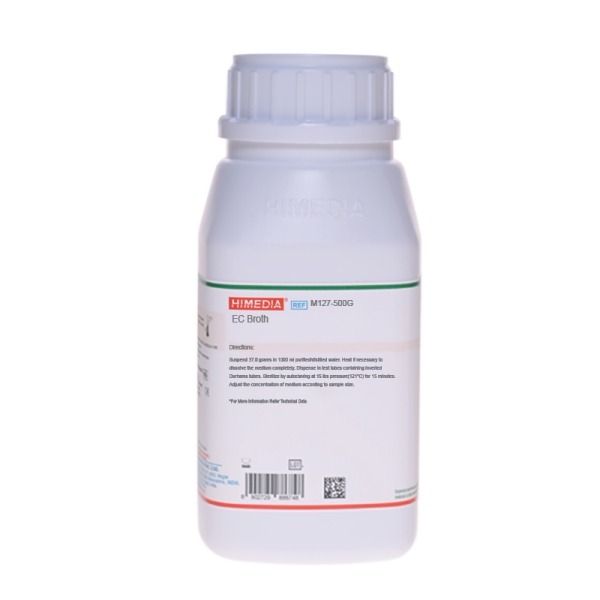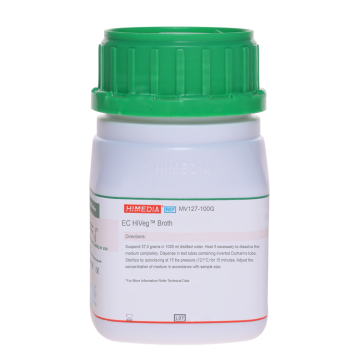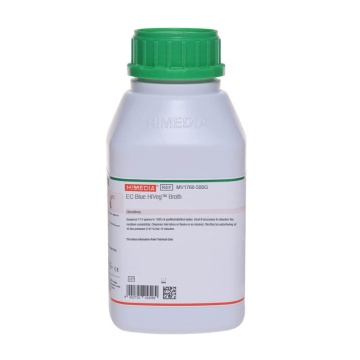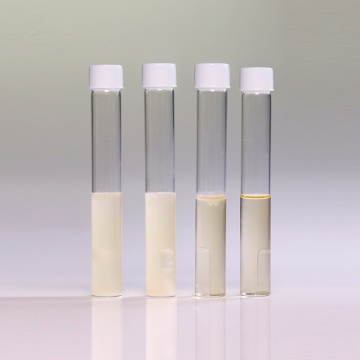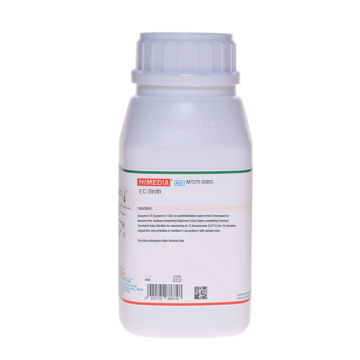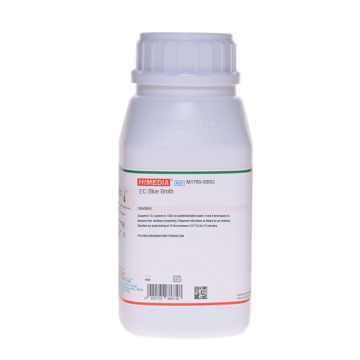 Your enquiry has been submitted
Your enquiry has been submitted
EC Broth
Coliforms - Enrichment#CC293D
Intended Use:
Recommended for the selective enumeration of presumptive Escherichia coli by MPN technique from water samples and food samples.
Composition**
| Ingredients | g/L |
|---|---|
| Tryptone | 20.000 |
| Lactose | 5.000 |
| Bile salts mixture | 1.500 |
| Dipotassium hydrogen phosphate | 4.000 |
| Potassium dihydrogen phosphate | 1.500 |
| Sodium chloride | 5.000 |
| Final pH (at 25°C) | 6.9±0.2 |
**Formula adjusted, standardized to suit performance parameters
Directions
Suspend 37.0 grams in 1000 ml purified/distilled water. Heat if necessary to dissolve the medium completely. Dispense in test tubes containing inverted Durhams tube. Sterilize by autoclaving at 15 lbs pressure (121°C) for 15 minutes. Adjust the concentration of medium in accordance with sample size.
Principle And Interpretation
EC Medium is used for detection of coliforms during bacteriological examination of water, milk and foods. It was originally described by Hajna and Perry (1). This medium was later used by Fishbein and Surkiewicz to carry out Escherichia coli confirmatory tests (2). It is also used in MPN methods (3) and is often used for confirmation of coliforms. The procedure employing EC Medium provides information regarding the source of the coliform group (fecal or non-fecal) when used as a confirmatory test (4). EC Broth should not be used for the direct isolation of coliforms since prior enrichment in a presumptive medium for optimal recovery of faecal coliforms is required. Tryptone provides nitrogenous and carbonaceous compounds, long chain amino acids and other essential growth nutrients. Lactose is the fermentable sugar. Bile salts mixture inhibit gram-positive bacteria especially bacilli and faecal Streptococci. Phosphates control the pH during fermentation of lactose. Gas production in a fermentation tube within 24 hour or less is a presumptive evidence of the presence of coliform bacteria. This medium can be used at 37°C for the detection of coliform organisms or at 44.5°C for the isolation of Escherichia coli from water and shellfish) or 45.5°C for foods.
When using sample more than 10 ml, the medium must be reconstituted at a concentration equivalent to that specified on the directions, once the sample is added, the working procedure is as follows:
Transfer a loopful of culture from all the tubes of Lauryl Sulphate Broth (M080) showing gas formation within 24 hours and from all the tubes showing bacterial growth within 48 hours to EC Broth tubes. Within 30 minutes from the inoculum, place the tubes in a water bath and incubate at 44°C for 24 hours. Consider the growth showing gas production as positive.
Calculate the density of the faecal coliform organisms by using MPN tables. False-negative reactions in recovering coliforms from water supplies can occur due to low pH, refrigeration and use of bactericidal or bacteriostatic agents (5).
Gas formation at 44.5°C or 45.5°C (and 37°C) Escherichia coli, possibly also other coliforms.
Gas formation at 37°C Coliform bacteria without Escherichia coli.
Type of specimen
Food samples; Water sample.
Specimen Collection and Handling
For food and dairy samples, follow appropriate techniques for sample collection and processing as per guidelines (6,7,8). For water samples, follow appropriate techniques for sample collection, processing as per guidelines and local standards (9).
After use, contaminated materials must be sterilized by autoclaving before discarding.
Warning and Precautions
Read the label before opening the container. Wear protective gloves/protective clothing/eye protection/face protection. Follow good microbiological lab practices while handling specimens and culture. Standard precautions as per established guidelines should be followed while handling specimens. Safety guidelines may be referred in individual safety data sheets.
Limitations
- For identification, organisms must be in pure culture.
- Morphological, biochemical and/or serological tests should be performed for final identification.
Performance and Evaluation
Performance of the medium is expected when used as per the direction on the label within the expiry period when stored at recommended temperature.
Quality Control
Appearance Cream to yellow homogeneous free flowing powder
Colour and Clarity of prepared medium Yellow coloured, clear solution without any precipitate
Reaction Reaction of 3.7% w/v aqueous solution at 25°C. pH : 6.9±0.2
pH 6.70-7.10
Cultural Response Cultural characteristics observed after an incubation at 44.5°C ± 0.2 for 24 hours.
| Organism | Inoculum (CFU) | Growth | Gas |
|---|---|---|---|
| Klebsiella pneumoniae ATCC 13883 (00097*) | 50-100 | good-luxuriant | positive reaction |
| Pseudomonas aeruginosa ATCC 27853 (00025*) | 50-100 | fair to good | negative reaction |
| Enterococcus faecalis ATCC 29212 (00087*) | >=104 | inhibited | |
| ** Bacillus spizizenii ATCC 6633 (00003*) | >=104 | inhibited | |
| Escherichia coli ATCC 25922 (00013*) | 50-100 | good-luxuriant | positive reaction |
| # Klebsiella aerogenes ATCC 13048 (00175*) | >=104 | inhibited |
Key *- Corresponding WDCM Numbers ;
# - Formerly known as Enterobacter aerogenes **Formerly known as Bacillus subtilis subsp. spizizenii
Storage and Shelf Life
Store between 10-30°C in a tightly closed container and the prepared medium at 15-30°C. Use before expiry date on the label. On opening, product should be properly stored dry, after tightly capping the bottle in-order to prevent lump formation due to the hygroscopic nature of the product. Improper storage of the product may lead to lump formation. Store in dry ventilated area protected from extremes of temperature and sources of ignition Seal the container tightly after use. Product performance is best if used within stated expiry period.
Disposal
User must ensure safe disposal by autoclaving and/or incineration of used or unusable preparations of this product. Follow established laboratory procedures in disposing of infectious materials and material that comes into contact with sample must be decontaminated and disposed of in accordance with current laboratory techniques (9,10).
Reference
- Hajna A. A. and Perry C. A., 1943, Am. J. Public Health, 33:550.
- Fishbein M. and Surkiewicz B. F., 1964, Appl. Microbiol., 12:127.
- Lipps WC, Braun-Howland EB, Baxter TE, eds. Standard methods for the Examination of Water and Wastewater, 24th ed. Washington DC:APHA Press; 2023.
- Lapage S., Shelton J. and Mitchell T., 1970, Methods in Microbiology', Norris J. and Ribbons D., (Eds.), Vol. 3A, Academic Press, London.
- Ray B., 1986, J. Food Prot., 49:651.
- Rice E.W., Baird, R.B., Eaton A. D., Clesceri L. S. (Eds.), 2012, Standard Methods for the Examination of Water and Wastewater, 22nd ed., APHA, Washington, D.C.
- Marshall, (Ed.), 1993, Standard Methods for the Examination of Dairy Products, 16th Ed., American Public Health Association, Washington, D.C.
- Salfinger Y., and Tortorello M.L. Fifth (Ed.), 2015, Compendium of Methods for the Microbiological Examination of Foods, 5th Ed., American Public Health Association, Washington, D.C.
- Wehr H. M. and Frank J. H., 2004, Standard Methods for the Microbiological Examination of Dairy Products, 17th Ed., APHA Inc., Washington, D.C.
- Isenberg, H.D. Clinical Microbiology Procedures Handbook. 2nd Edition.
- Jorgensen, J.H., Pfaller, M.A., Carroll, K.C., Funke, G., Landry, M.L., Richter, S.S and Warnock., D.W.(2015) Manual of Clinical Microbiology, 11th Edition. Vol. 1.
| Product Name | EC Broth |
|---|---|
| SKU | M127 |
| Product Type | Regular |
| Physical Form | Powder |
| Origin | Animal |
| Packaging type | HDPE |
| References | 1. Hajna A. A. and Perry C. A., 1943, Am. J. Public Health, 33:550. 2.Fishbein M. and Surkiewicz B. F., 1964, Appl. Microbiol., 12:127. 3.Greenberg A. E., Clesceri L. S. and Eaton A. D., (Eds.), 2005, Standard Methods for the Examination of Water andWastewater, 21st ed., APHA, Washington, D.C. 4.Marshall, (Ed.), 1993, Standard Methods for the Examination of Dairy Products, 16th Ed., American Public HealthAssociation, Washington, D.C. 5.Ray B., 1986, J. Food Prot., 49:651. 6.Rice E.W., Baird, R.B., Eaton A. D., Clesceri L. S. (Eds.), 2012, StandardMethods for the Examination of Water and Wastewater, 22nd ed., APHA, Washington, D.C. 6.Downes F. P. and Ito K., (Ed.), 2001, Compendium of Methods for the Microbiological Examination of Foods, 4th Ed.,American Public Health Association, Washington, D.C. 7.Isenberg, H.D. Clinical Microbiology Procedures Handb0ook. 2nd Edition. 8.Jorgensen,J.H., Pfaller , M.A., Carroll, K.C., Funke, G., Landry, M.L., Richter, S.S and Warnock., D.W. (2015)Manual of Clinical Microbiology, 11th Edition. Vol. 1. 9.Lapage S., Shelton J. and Mitchell T., 1970, Methods in Microbiology, Norris J. and Ribbons D., (Eds.), Vol. 3A, AcademicPress, London.10.Wehr H. M. and Frank J. H., 2004, Standard Methods for the Microbiological Examination of Dairy Products, 17th Ed.,APHA Inc., Washington, D.C. |
| Customized Product Available | No |



